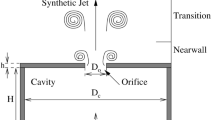Abstract
In the present research, dissipating free surface vortices over the intakes by designing a hydraulic anti-vortex method is studied experimentally. In this method, an up-stream submerged water jet is used as a hydraulic-based anti-vortex mechanism. The imposed jet acts as a point source of external momentum to the formed free surface area. The added momentum changes the hydrodynamic balance of the vortex zone, and leads to instability and disability of the vortex to form and develop. Experiments were conducted on a projected horizontal pipe intake to investigate the efficiency of the proposed anti-vortex hydraulic device on dissipating and preventing formation of free surface vortices. Results show that the efficiency of the imposed jet is dependent on the jet linear momentum and vertical distance between the nozzle and intake positions. Moreover, the critical submergence of the intake can potentially reduce up to the nozzle submergence in which less than 10% of the jet momentum is required by decreasing nozzle submergence about 50%. Finally, an empirical equation is suggested to predict the critical submergence of the intake with respect to the jet linear momentum and the nozzle submergence.












Similar content being viewed by others
References
Suerich-Gulick F, Gaskin S, Villeneuve M, Parkinson É. (2014) Characteristics of free surface vortices at low-head hydropower intakes. ASCE J Hydraul Eng 140:291–299
Knauss J (1987) “Swirling flow problems at intakes”, IAHR hydraulic structures design manual, vol 1, Balkema, Rotterdam, pp 57–76
Möller G, Detert M, Boes RM (2015) Vortex-Induced Air Entrainment Rates at Intake. ASCE J Hydraul Eng 141(11):1–9
Ansar M, Nakato T (2001) Experimental study of 3D pump-intake flows with and without cross flow. ASCE J Hydraul Eng 127(10):825–834
Khodashenas SR, Roshan R, Sarkardeh H, Azamathulla H.Md (2010) Vortex study at orifice spillways of Karun III dam. J Dam Eng XXI(2):131–142
Sarkardeh H, Zarrati AR, Roshan R (2010) Effect of intake head wall and trash rack on vortices. J Hydraul Res 48(1):108–112. doi:10.1080/00221680903565952
Sarkardeh H, Zarrati AR, Jabbari E, Roshan R (2012) Discussion of prediction of intake vortex risk by nearest neighbors modeling. ASCE J Hydraul Eng 137(6):701–705. doi:10.1061/(ASCE)HY.1943-7900.0000344
Sarkardeh H, Jabbari E, Zarrati AR, Tavakkol S (2013) Velocity field in a reservoir in the presence of an air-core vortex. ICE J Water Manag 164(4):193–200. doi:10.1680/wama.13.00046
Taghvaei SM, Roshan R, Safavi Kh, Sarkardeh H (2012) Anti-vortex structures at hydropower dams. Int J Phys Sci 7(28):5069–5077. doi:10.5897/IJPS12.387
Yildirim N, Eyüpoğlu A, Tastan K (2012) Critical submergence for dual rectangular intakes. ASCE J Energy Eng 138(4):237–245
Azarpira M, Sarkardeh H, Tavakkol S, Roshan R, Bakhshi H (2014) Vortices in dam reservoir: a case study of Karun III Dam. Sādhanā 39(5):1201–1209
Suerich-Gulick F, Gaskin S, Villeneuve M, Parkinson É. (2014) Free surface intake vortices: Theoretical model and measurements. J Hydraul Res 52(4):502–512
Padmanabhan M (1984) Air ingestion due to free-surface vortices. J Hydraul Eng 12:1855–1859. doi:10.1061/(ASCE)0733-9429(1984)110:12(1855)
Keller J, Möller G, Boes RM (2014) PIV measurements of air-core intake vortices. J Flow Meas Instrum 40:74–81
Pfister M, Chanson H (2014) Two-phase air-water flows: Scale effects in physical modeling. J Hydrodyn 26(2):291–298
Tastan K, Yildirim N (2014) Effects of Froude, Reynolds, and Weber numbers on an air-entraining vortex. J Hydraul Res 52(3):421–425
Fazel Z, Fazelian M, Sarkardeh H (2017) Development of a device for measuring air–water flow characteristics. Int J Civil Eng 15(2):195–203. doi:10.1007/s40999-016-0101-7
Monshizadeh M, Tahershamsi A, Rahimzadeh H, Sarkardeh H (2017) Experimental investigation of dynamics of the air-core vortices and estimating the air entrainment rate at a horizontal intake. Modares Mech Eng 17(8):59–76 (in Persian)
Suerich-Gulick F, Gaskin SJ, Villeneuve M, Parkinson É (2014) Free surface intake vortices: scale effects due to surface tension and viscosity. J Hydraul Res 52(4):513–522
Khadem-Rabe B, Ghoreishi-Najafi SH, Sarkardeh H (2016) Numerical simulation of anti-vortex devices at water intakes. ICE J Water Manag. doi:10.1680/jwama.16.00051
Sarkardeh H, Zarrati AR, Jabbari E, Marosi M (2014) Numerical simulation and analysis of flow in a reservoir in the presence of vortex. J Eng Appl Comput Fluid Mech 8(4):598–608. doi:10.1080/19942060.2014.11083310
Naghian M, Lashkarbolok M, Jabbari E (2017) Numerical simulation of turbulent flows using a least squares based meshless method. Int J Civil Eng 15(1):77–87. doi:10.1007/s40999-016-0087-1
Granger R (1966) Steady 3-dimentional vortex flow. J Fluid Mech 25(3):557–576
Carriveau R, Kopp G, Baddour R (2009) Stretching-sustained intake vortices. J Hydraul Res 47(4):486–491
Borghei SM, Kabiri-Samani AR (2010) Effect of anti-vortex plates on critical submergence at a vertical intake. J Sci Iran 17(2):89–95
Trivellato F (2010) Anti-vortex devices: laser measurements of the flow and functioning. J Opt Lasers Eng 48(5):589–599
Sohn CH, Ju NG, Gowda BHL (2009) Draining from cylindrical tanks with vane-type suppressors, a PIV study. J Vis 12(4):347–360
Mahyari MN, Karimi H, Naseh H, Mirshams M (2010) Numerical and experimental investigation of vortex breaker effectiveness on improvement in launch vehicle ballistic parameters. J Mech Sci Technol 24(10):1997–2006
Amiri SM, Zarrati AR, Roshan R, Sarkardeh H (2011) Surface vortex prevention at power intakes by horizontal plates. ICE J Water Manag 164(4):193–200. doi:10.1680/wama.1000009
Monshizadeh M, Tahershamsi A, Rahimzadeh H, Sarkardeh H (2017) Comparison between hydraulic and structural based anti-vortex methods at intakes. Eur Phys J Plus 132:329. doi:10.1140/epjp/i2017-11608-4
Odgaard JA (1986) Free-surface air-core vortex. ASCE J Hydraul Eng 112(7):610–620
Acknowledgements
The authors would like to express their sincerely appreciations to the assistance provided by Department of Hydraulic Engineering, Water Research Institute of Iran, and Laboratory of Fluid Mechanic of Mechanical Engineering Department (Amirkabir University of Technology) for providing all needed laboratorial supports.
Author information
Authors and Affiliations
Corresponding author
Ethics declarations
Funding
No funding information available.
Rights and permissions
About this article
Cite this article
Monshizadeh, M., Tahershamsi, A., Rahimzadeh, H. et al. Vortex Dissipation Using a Hydraulic-Based Anti-Vortex Device at Intakes. Int J Civ Eng 16, 1137–1144 (2018). https://doi.org/10.1007/s40999-017-0266-8
Received:
Revised:
Accepted:
Published:
Issue Date:
DOI: https://doi.org/10.1007/s40999-017-0266-8




